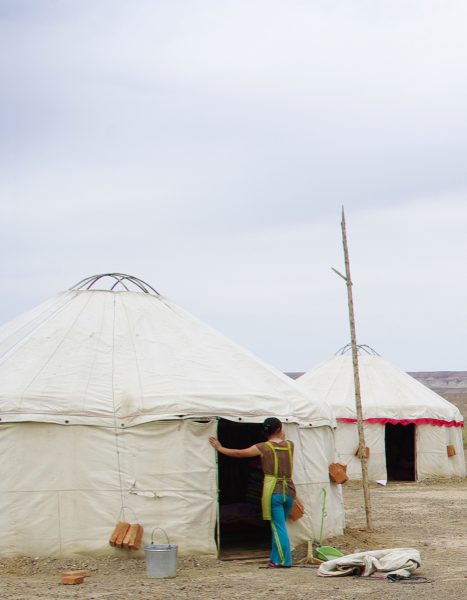 Nowadays, most Mongols live in modern apartment blocks or fixed residences. However, you’ll still find plenty of Mongol people maintaining their nomadic heritage and living on the grasslands in a type of portable domed tent known as a ger or yurt. Some people even alternate between the two; living in urban housing for part of the year and then shifting to a ger in order to tend to their livestock. The use of these unusual abodes dates back to the time of the mighty Genghis Khan, roughly around about the 12th century. With their bright white exteriors and perfectly rounded shape, these magnificent gers look like glittering pearls scattered across the jade-hued grasslands.
Nowadays, most Mongols live in modern apartment blocks or fixed residences. However, you’ll still find plenty of Mongol people maintaining their nomadic heritage and living on the grasslands in a type of portable domed tent known as a ger or yurt. Some people even alternate between the two; living in urban housing for part of the year and then shifting to a ger in order to tend to their livestock. The use of these unusual abodes dates back to the time of the mighty Genghis Khan, roughly around about the 12th century. With their bright white exteriors and perfectly rounded shape, these magnificent gers look like glittering pearls scattered across the jade-hued grasslands.
They are made by first erecting a series of wooden lattice frames into a circular shape and then securing them with rope. This forms a self-supporting cylinder that is approximately head height. A door frame is then fitted at the front, while roof poles are used to give extra support. Finally, a canvas typically made from sheep’s wool is drawn across the wooden skeleton and the ger is complete. To give the ger additional stability during inclement weather, a heavy weight is suspended from the centre roof pole.
The ger is ideal for both warm summers and harsh winters, since it is spacious, well-ventilated, but also well-insulated. Its conical roof is perfect for shedding rain, its white exterior is designed to reflect the sunlight during the peak of summer, and its ground-hugging base protects it against strong winds. Smaller gers are typically designed to accommodate up to 10 people, while larger ones can house over 20! Skilled Mongols can erect a ger within half an hour and dismantle it just as quickly, making it the ideal home for the wandering nomad. Once packed up on the back of a yak or camel, it can be easily transported to the next destination. In short, it’s the original mobile-home!
According to tradition, the door to the ger should typically face south and the interior layout should be separated into approximately eight sections: the north, northwest, west, southwest, northeast, east, southeast, and centre. In the northern quarters, there is usually an eight-legged table that is used for keeping cosy quilts, exquisite rugs, and other clothing items. Men’s clothes must be placed above women’s clothes and it is considered taboo to put the neck of any piece of clothing facing the doorway, as this is a practice reserved for the deceased.
The northwest is a holy area reserved solely for Buddha. It is resplendent with shrines and niches, all containing Buddhist statues that have been safely locked away. During religious festivals, the occupants of the ger will light candles and make offerings to these statues while praying for wealth, longevity, and good fortune. The wild western quarter is designated as the man’s private kingdom, full of guns, knives, saddles, and wrestling gear.
The southwest is where yoghurt tanks and more saddles are kept, while the northeast houses cases of women’s clothes and jewellery. The eastern quarter acts as a sort of makeshift pantry, with meat, vegetables, fruits, and cooking utensils arranged into tiers on a special rack to keep them separate. The southeast is a much more flexible area, as it can be utilised in a number of ways depending on the season. In spring, it is filled with water buckets and dried cow’s dung, which is burned as fuel. During summer and autumn, a yoghurt tank and various clay utensils are added for the making of milk products. Under emergency circumstances, it is sometimes even used as a shelter for newly-born calves!
Finally the centre, arguably the most significant section of the ger, is reserved for the fire stove. After a ger has been erected, the first thing that the occupants must do is decide on the position of the stove. Fire is the lifeblood of any Mongolian household, as it provides the means to boil water for tea, cook family meals, or simply keep the ger warm. For this reason, it is of paramount importance that the stove is positioned correctly within the ger.
If you happen to be visiting a ger, there are a number of customs and taboos that you should be aware of. One must not approach a ger by automobile or on horseback within a certain radius. Touching the entryway or the centre roof poles of the ger is deemed impolite. Never step on or over a saddle, as the Mongols’ have a deep-rooted reverence for the horse and damaging or disregarding a saddle is considered highly disrespectful. Similarly, you shouldn’t sit in front of or near Buddhist shrines out of respect for the Buddha. Lastly, you should only take a seat after being invited to do so by your host, with male and female guests sitting separately. Remember, while the Mongols are renowned for their warm-hearted nature, these are the descendants of Genghis Khan, so the last thing you want to do is offend them!